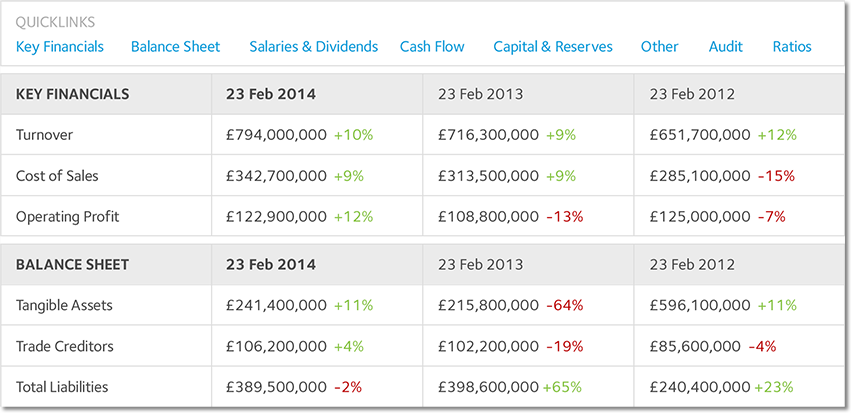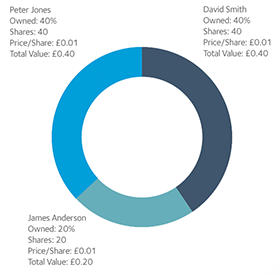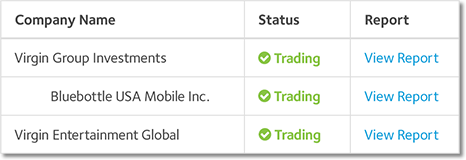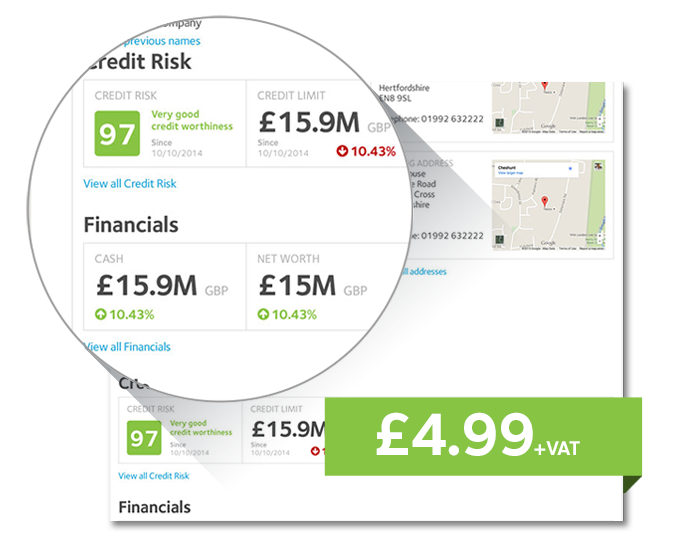Avoid risks to your business with a company credit score and credit limit
Check the credibility of a potential customer or supplier and their ability to repay debt. All reports show a credit score and suggest an actionable credit limit.


Check for outstanding debts or legal issues with CCJ history
Understand how a company has dealt with their past debts and whether they have any unsatisfied County Court Judgements (CCJs). Any CCJs or Scottish Decrees from the last 6 years are shown as well as other legal notices, mortgages or charges.
Evaluate financial performance with up to 5 years of accounts
With our reports, you can access up to 5 years of a company's financial history including profit and loss, salaries and dividends, balance sheet, capital & reserves and more, allowing you to understand their size and potential to grow.

Access Director and Shareholder information
View details of current and previous shareholders, directors and secretaries, including shareholders equity. You can also get more information on each director with our free director reports, including other companies they are associated with.



View the group structure of a company
Gain insight into how a company is governed and funded; each report visualises a group structure including any holding or subsidiary companies and their trading status.
Get an overview of company information
Discover essential information including company type, business activity, incorporation date, registered address, trading address and any previous names.

Why choose us
Quality data
Our company reports give you an up to date and in-depth view, including full accounts information.
Great value
Competitive prices that are hard to beat, get a single report for £4.99 or unlimited reports for less than £1 a day.
Simple to use
View each report instantly from your online management portal, or download as a PDF for convenience.
FAQs
Credit Rating
Why is a company’s credit rating score low?
Why is the company’s credit rating not recent?
Will the insolvency rates in my industry affect my company’s credit score?
Which variables are used to calculate a company’s credit rating?
Will my credit rating be affected by when I file my accounts?
General
Where is the information in the credit reports sourced from?
What information is included in the company credit reports?
A different address is shown on the report than the one I have for the company. Why?
Some of the information included in the sample report is not included in my company report. Why not?
Will the reports be emailed to me?
Financials & County Court Judgements
What does ‘Analysed - Non-balancing’ mean on the report’s balance sheet?
Why is Turnover shown as ‘not reported’ when I am sure that the company is turning money over?
What do County Court Judgements (CCJs) mean?
Do the reports show Scottish Decrees from the Sheriff Courts?
Credit Rating
What is a credit rating?
A credit rating is a score assigned to each company as an indicator of their creditworthiness, meaning the likelihood that they would be able to pay money owed in full in a timely manner. The rating given ranges from 0-100 with 100 being the most creditworthy. The credit rating should be interpreted differently depending on whether the company have filed accounts or not.
Rating key for a company where accounts have been filed
| 71-100 | Very good creditworthiness |
|---|---|
| 51-70 | Good creditworthiness |
| 30-50 | Creditworthy |
| 0-29 | Caution - Credit at your discretion |
| N/A | Reason will be displayed in the report (e.g. In liquidation, dissolved) |
Rating key for a new company where no accounts have filed
| 51-100 | Low risk |
|---|---|
| 31-50 | Moderate risk |
| 0-29 | Caution - High risk |
| N/A | Reason will be displayed in the report (e.g. In liquidation, dissolved) |
Why is a company’s credit rating score low?
Credit agencies do not disclose the exact reasons as to why credit ratings are set at the level they are. If you would like more information about the reasoning for the low credit score, we advise that you contact your business advisor or accountant to gain the insight of an industry professional.
Why is the company’s credit rating not recent?
The credit rating shown on the reports is the most recent credit rating published by the credit agency. Credit ratings are only updated when there is a change in the rating, so an old credit rating shows that the company’s credit rating has not risen or fallen since the date it was assigned the rating.
Will the insolvency rates in my industry affect my company’s credit score?
Yes, as part of the credit score calculations, insolvency figures for your industry will influence the credit score you are given. This is integral to the utility of the credit rating system as credit rating scores act as an indicator of the likelihood of a company becoming insolvent within the next 12 months.
Which variables are used to calculate a company’s credit rating?
A company’s credit rating score is calculated using a complex algorithm incorporating a large number of variables for the company itself and the industry in which it operates so as to ensure the accuracy of the rating. The credit rating is calculated using the following variables, amongst others:
- Age of company
- Current assets (e.g. inventory, cash, short-term investments etc.)
- History of directors
- Company payment history
- Liabilities (e.g. mortgages, wages, taxes, loans etc.)
- Current and historical CCJ information
- Historical financial information
- Auditor’s information
The credit rating predicts the likelihood of the company becoming insolvent in the next 12 months and can be used as a solid indicator of whether extending credit to these companies carries a considerable amount of risk.
Will my credit rating be affected by when I file my accounts?
It can be. The credit rating calculation takes into account the late filing of accounts, so your credit score may fall temporarily as the due date for your accounts comes closer. Assuming your accounts are filed on time and that your financials have not got worse, your credit rating should rebound from this temporary drop. The late filing of accounts is a factor as it has been a prover indicator of company failure in the past, with companies late filing their accounts being 3 times as likely to fail.
General
Where is the information in the credit reports sourced from?
The information in the reports is sourced from Companies House and so has been submitted in accordance with the submission rules dictated by Companies House.
What information is included in the company credit reports?
Company credit reports typically include the following information:
- Base company information (name, registered office and service address, SIC code, date of registration, company types)
- 5 years full financial accounts
- Credit rating and credit limit
- CCJ history
- Group structure
- Details of directors and secretaries
- Share structure
- Key ratios
- Event history (changes to board members, secretaries, accounts, directors etc.)
A different address is shown on the report than the one I have for the company. Why?
The address listed on the company reports is the company’s registered address which they have submitted to Companies House. The address you have may be the address of one of their premises or accountant.
I received an email stating that a company’s information has been updated. What do I need to do to see this information?
In order to view the details of what has changed within the company, you must purchase a new version of the report as the details of any previously purchased reports are only accurate as of the day you purchased the report. In order to purchase the report you can either follow the link provided in the email and select ‘Buy Report’, or use our company search function to find the company for which you’d like the report.
Some of the information included in the sample report is not included in my company report. Why not?
The company reports we provide contain all of the most up-to-date information submitted by companies to Companies House. If a company has not yet filed its first set of annual accounts, there will be no information in the Financials section of the Company Report.
Will the reports be emailed to me?
No, the reports are not emailed to you, instead you can access them any time from your Company Search MadeSimple account. Simply login to your account, click ‘My UK Company Reports’ from the ‘My Account’ section and select the Company Report you wish to view from the list. From here you will also be able to download the report as a PDF by selecting ‘Download PDF’.
Financials & County Court Judgements
What does ‘Analysed - Non-balancing’ mean on the report’s balance sheet?
This occurs when the finances declared on the company’s balance sheet do not balance due to an error in the company’s financial reporting. As such, we are not able to responsibly assign a credit rating to this company until this imbalance has been resolved.
Why is Turnover shown as ‘not reported’ when I am sure that the company is turning money over?
Companies with annual turnovers under a certain amount fall under the Disclosure Threshold for financial reporting and so do not have to submit their turnover or detailed profit and loss accounts annually. More information about financial audit exemptions.
What do County Court Judgements (CCJs) mean?
A County Court Judgement is a court order registered against companies who have failed to repay money owed. If the full amount hasn’t been paid within a month of a claim by the creditor, a CCJ will stay on a company’s record for 6 years.
Each CCJ will also have a status next to it depicting its current state:
- SS - The CCJ has been been satisfied (fully paid) by the debtor
- JG - The CCJ is still in active judgement and is still unsatisfied
Do the reports show Scottish Decrees from the Sheriff Courts?
Yes, Scottish Decrees are shown in the reports alongside CCJs.



